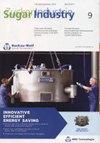Dextran-induced modifications of calcium carbonate particles precipitated during carbonatation
IF 0.2
4区 农林科学
Q4 FOOD SCIENCE & TECHNOLOGY
引用次数: 0
Abstract
The effects of high and low molecular mass dextran (T2000 and T40) on the size and shape of particles precipitated during carbonatation and their correlation with filtration performances were key to this study. Varying contents of T2000 and T40 dextran in sugar solutions corresponding to DS contents of thin juice were investigated. For particle size and shape analysis, static image analysis and laser particle size analysis were used. Both methods, static image analysis and laser diffraction, revealed that the presence of T2000 and T40 dextran leads to a higher amount of large-sized particles at the expense of small-sized particles, indicating pronounced agglomeration. The additional evaluation of shape parameters (circularity, roundness, solidity) obtained from static image analysis indicates that the agglomeration is oriented in the absence and in the presence of lower T40 dextran levels. Besides, non-oriented agglomeration, resulting in more round agglomerates with smoother surfaces, was found for samples loaded with T2000 dextran and high T40 dextran levels. Only the latter samples have shown to negatively affect the filtration performance. Thus, in the presence of T2000 dextran and high T40 dextran levels, the filtration was hampered. This appears to be mainly caused by a tighter packing of more round calcium carbonate agglomerates in the porous structure of the filter cake.右旋糖酐诱导的碳酸钙颗粒在碳酸化过程中沉淀的修饰
高分子量和低分子量葡聚糖(T2000和T40)对碳酸化过程中沉淀颗粒大小和形状的影响及其与过滤性能的相关性是本研究的重点。研究了与稀汁DS含量相对应的糖溶液中T2000和T40葡聚糖含量的变化。粒度和形状分析采用静态图像分析和激光粒度分析。静态图像分析和激光衍射两种方法都表明,T2000和T40葡聚糖的存在导致大颗粒数量增加,而小颗粒数量减少,表明明显的团聚。从静态图像分析中获得的形状参数(圆度,圆度,固体度)的附加评价表明,在没有和存在较低T40葡聚糖水平的情况下,团聚是定向的。此外,在T2000葡聚糖和T40葡聚糖含量较高的样品中,发现了非定向团聚,导致更圆的团聚,表面更光滑。只有后一种样品显示出对过滤性能的负面影响。因此,在存在T2000葡聚糖和高水平T40葡聚糖的情况下,过滤受到阻碍。这似乎主要是由于在滤饼的多孔结构中,更圆的碳酸钙团块的堆积更紧密。
本文章由计算机程序翻译,如有差异,请以英文原文为准。
求助全文
约1分钟内获得全文
求助全文
来源期刊

Sugar Industry-Zuckerindustrie
工程技术-食品科技
CiteScore
0.50
自引率
50.00%
发文量
22
审稿时长
18-36 weeks
期刊介绍:
Sugar Industry / Zuckerindustrie accepts original papers (research reports), review articles, and short communications on all the aspects implied by the journals title and subtitle.
 求助内容:
求助内容: 应助结果提醒方式:
应助结果提醒方式:


